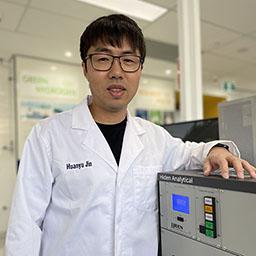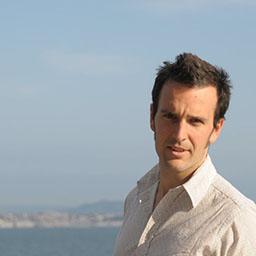The Stephen Wilkins Medal
The 2021 Stephen Wilkins medal has been awarded to Dr Huanyu Jin of the University of Adelaide for his PhD work on the development of new materials for next-generation clean energy technologies, a priority area of research in Australia.

Dr Jin, a Research Fellow in the School of Chemical Engineering and Advanced Materials, and Institute for Mineral and Energy Resources at The University of Adelaide, seeks to develop high-performance electrocatalysts with novel nanostructures for the efficient conversion of clean energy and its storage using hydrogen.
He has focused on atomically thin two-dimensional (2D) nanomaterials, in which the mechanism that governs the hydrogen evolution reaction is crucial.
The award was announced last week during the virtual Australian Synchrotron User Meeting, which showcases the achievements of scientists who have used the facility in their research.
Dr Jin's research, which has delivered excellent outcomes, has potential application in efficient, cost-effective and reliable electrolysers, fuel cells and batteries.
As part of a team led by Prof. Shi-Zhang Qiao from The University of Adelaide, where he completed his PhD, Dr Jin has published 30 papers in peer-reviewed journals and is highly cited.
Much of Dr Jin's work involves measurements on the soft X-ray spectroscopy and X-ray absorption spectroscopy beamlines at ANSTO's Australian Synchrotron, which he uses for the characterisation of materials. Using these X-ray techniques, Dr Jin aims to reveal the state and coordination environment of the active site in the 2D electrocatalysts at the atomic level that are particularly challenging to analyse using other techniques.
Other awards include the 2020 Doctoral Research Medal, the highest prize for outstanding PhD researcher at the University of Adelaide, and Best contribution to research quality awarded by Centre for Energy Technology, University of Adelaide.
Dr Jin was named among the 2020 World's Top 2% Scientists by Stanford University)
In 2021, he was awarded the prestigious Future Making Fellowship at the University of Adelaide.
The Stephen Wilkins Thesis Medal is awarded annually to the PhD student at an Australian or New Zealand University who is judged to have completed the most outstanding thesis of the past two years whose work was undertaken at and acknowledges the Australian Synchrotron, or the Australian National Beamline Facility (ANBF).
It can also be awarded to a PhD student whose work acknowledges and was undertaken under the auspices of the International Synchrotron Access Program (ISAP) or the Australian Synchrotron Research Program (ASRP).
The prize was established in honour of Stephen Wilkins, who was a stalwart of the Australian Synchrotron and was influential on several beamlines.
In the early 1980s, as one of the first enthusiastic proponents of synchrotron radiation in Australia, Steve Wilkins demonstrated how important this new tool would be to all the scientific disciplines.
Research Award

Dr Michael W. M. Jones, Senior Research Infrastructure Specialist (Synchrotron Science) Queensland University of Technology has received the Research Award from the Australian Synchrotron Users Advisory Committee for his contribution in developing and applying high-resolution synchrotron imaging techniques.
He was able to expand early work on the imaging of biological materials using soft X-rays to pioneering imaging using X-ray fluorescence microscopy and ptychography (a technique sometimes also called scanning X-ray diffraction microscopy).
Based on his knowledge and expertise in synchrotron science, Dr Jones assists associates at the Queensland University of Technology when experiments involve the use of a wide range of synchrotron techniques.
He has particular expertise in in operando and in situ dynamic nano-imaging and spectroscopy. Dr Jones has designed and carried out in situ experiments to simultaneously obtain chemical and structural information, and these methods are also highly effective for non-reversible systems, where there is only one opportunity to collect the data.
Michael Jones completed his PhD (2010 ) in nonlinear optics at QUT and received an ARC Super Science Fellowship at La Trobe University to work with Professors Andrew Peele and Leann Tilley in the ARC Centre of Excellence for Coherent X-ray Science.
In 2014 Dr Jones was appointed to the Australian Synchrotron, working as an Australian Synchrotron Fellow on the X-ray Fluorescence Microscopy beamline until his appointment at Queensland University of Technology.






